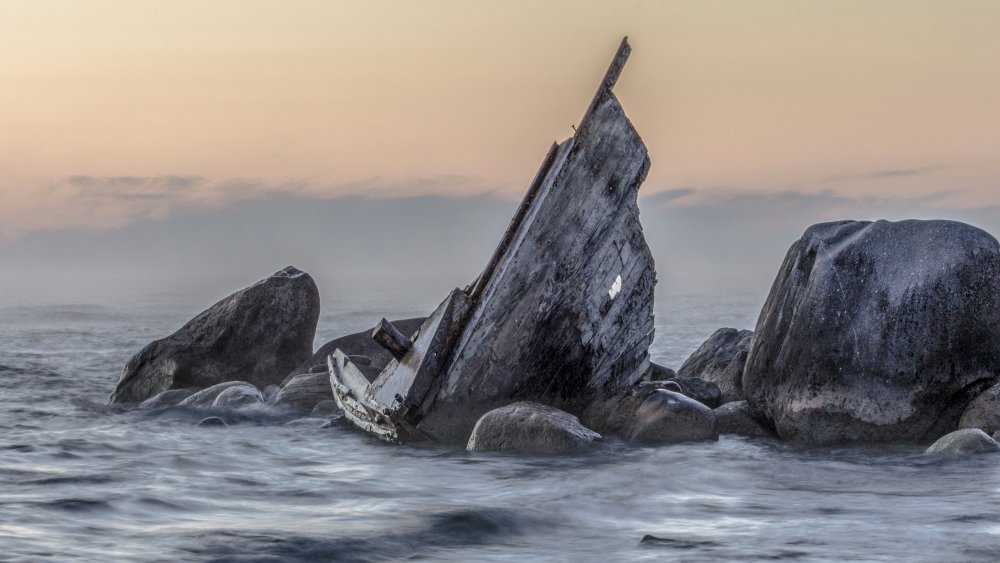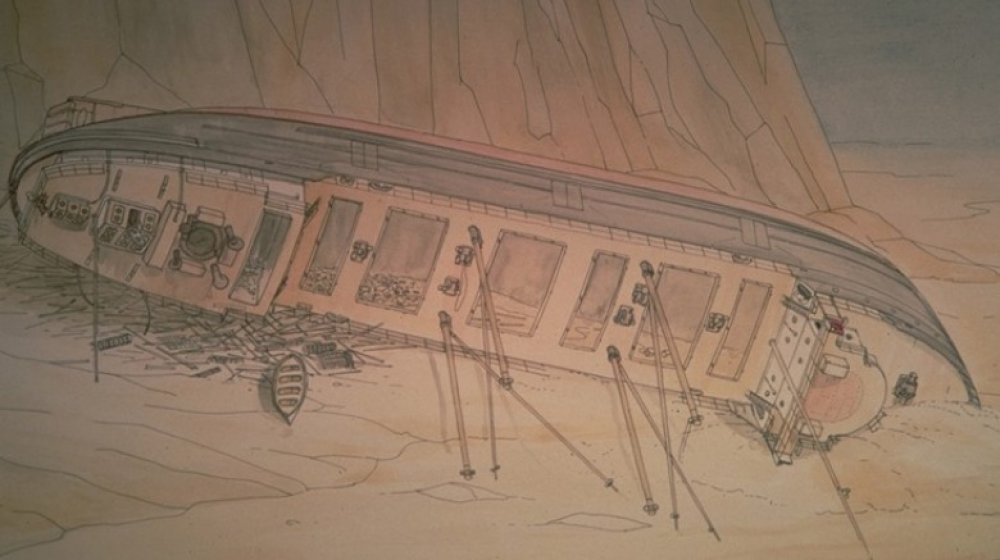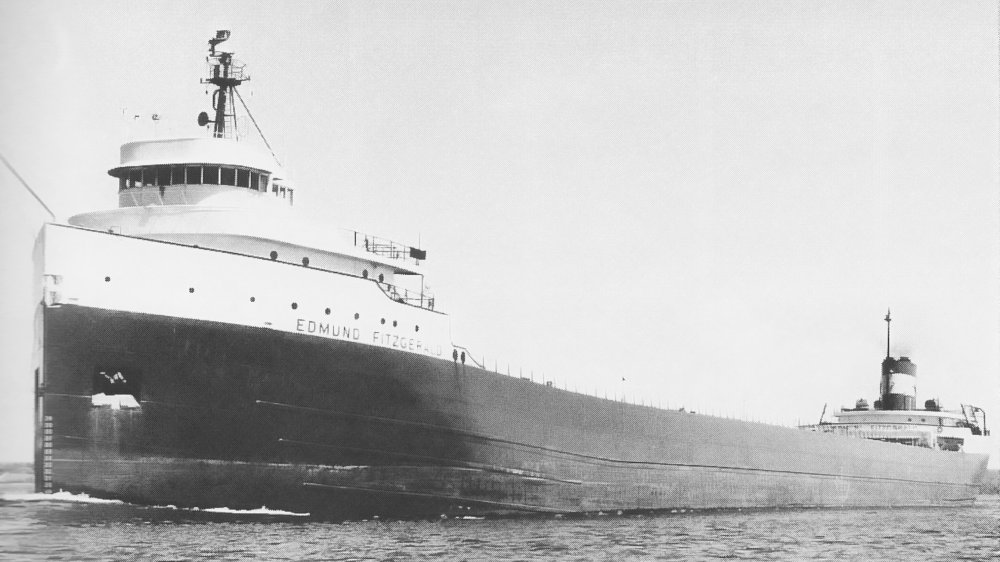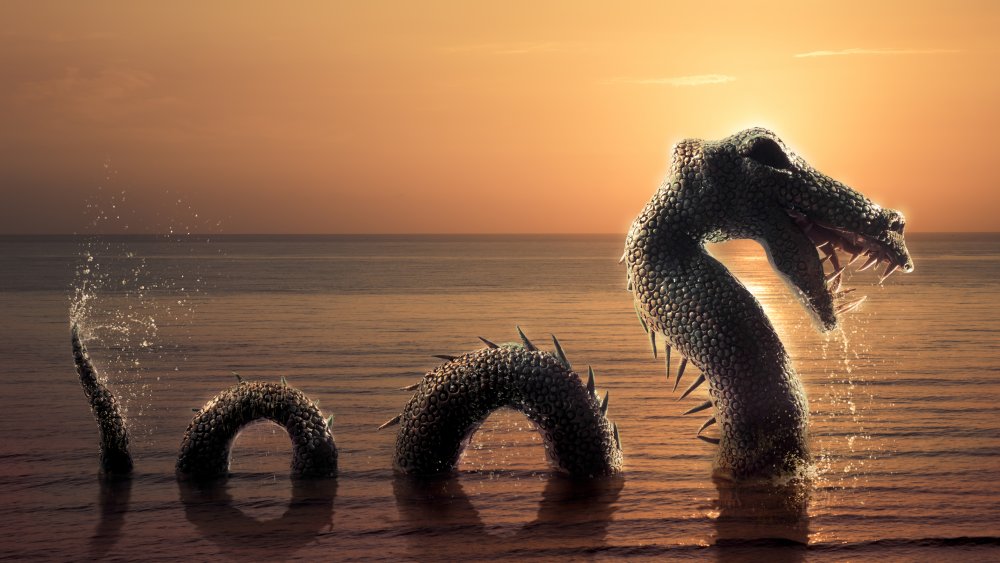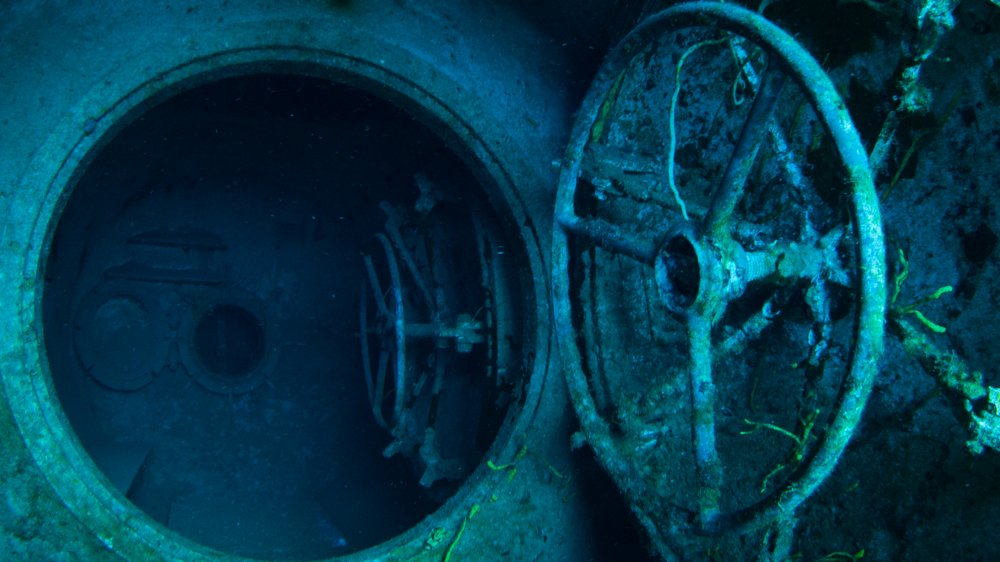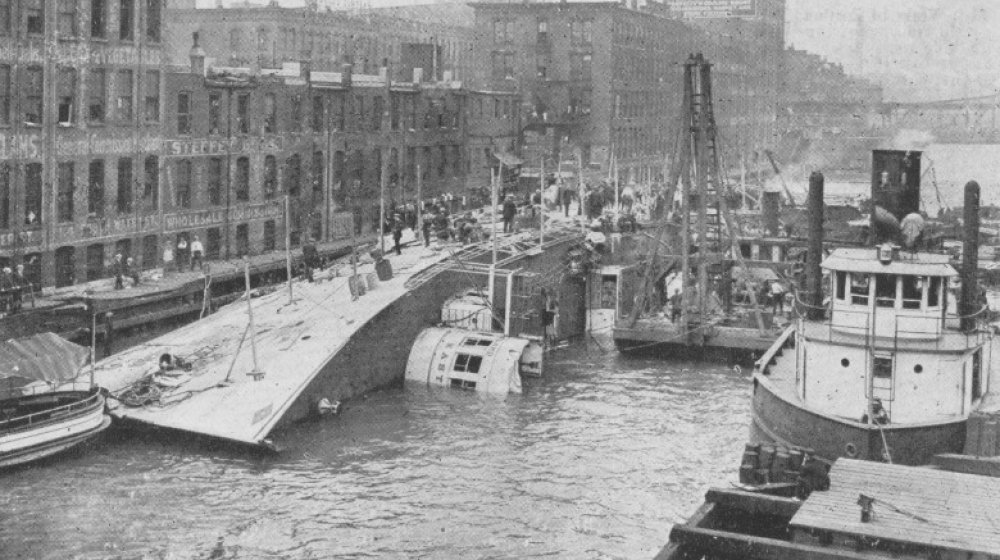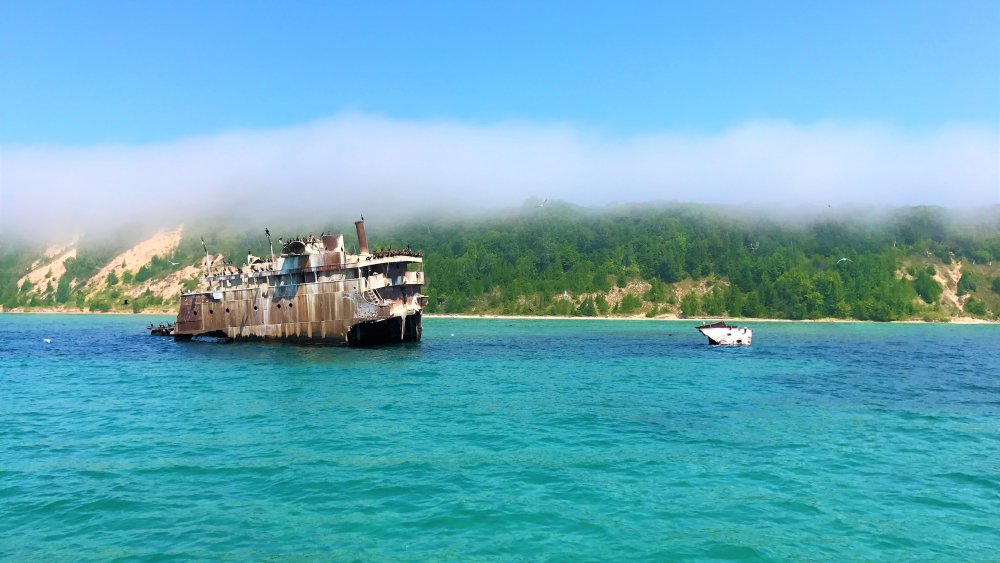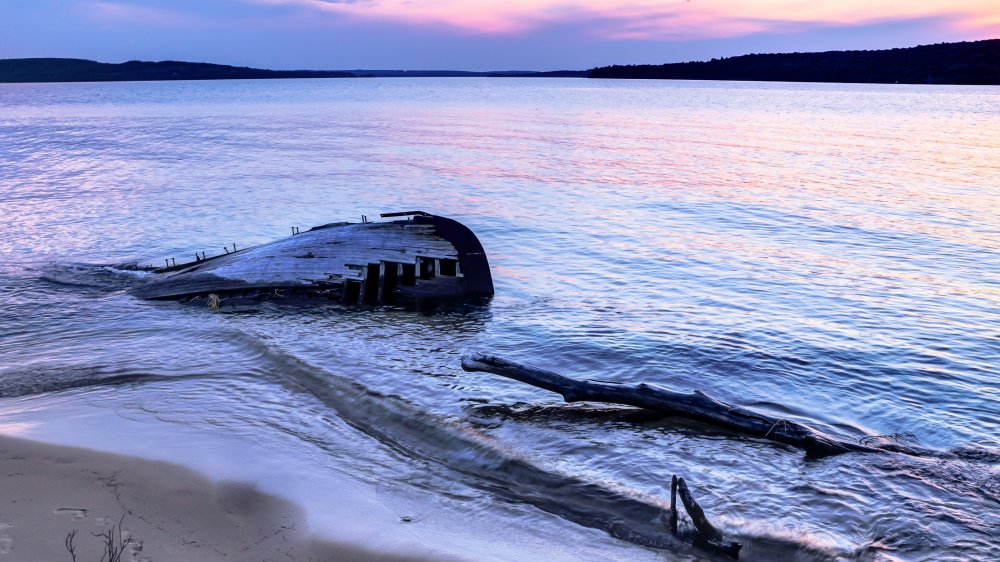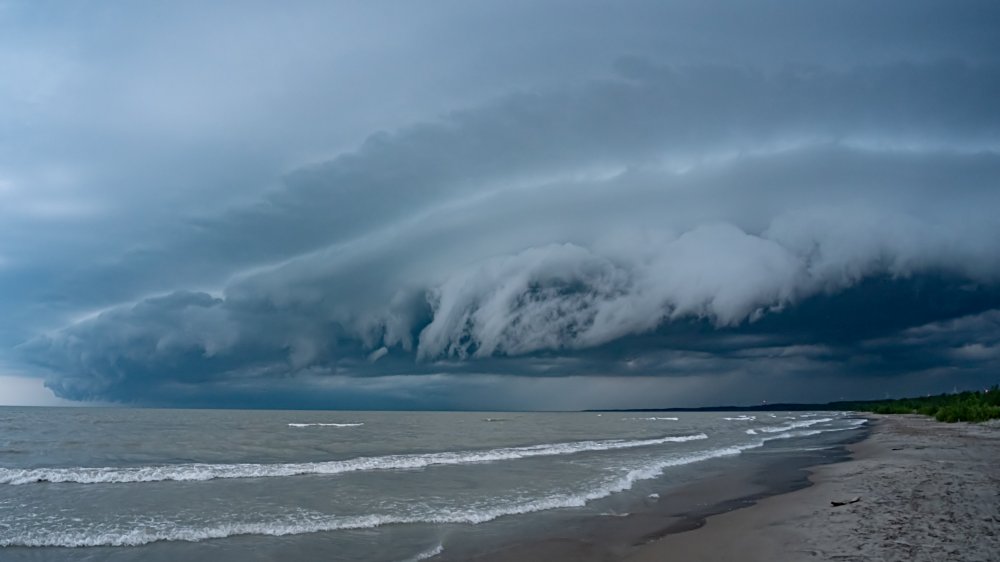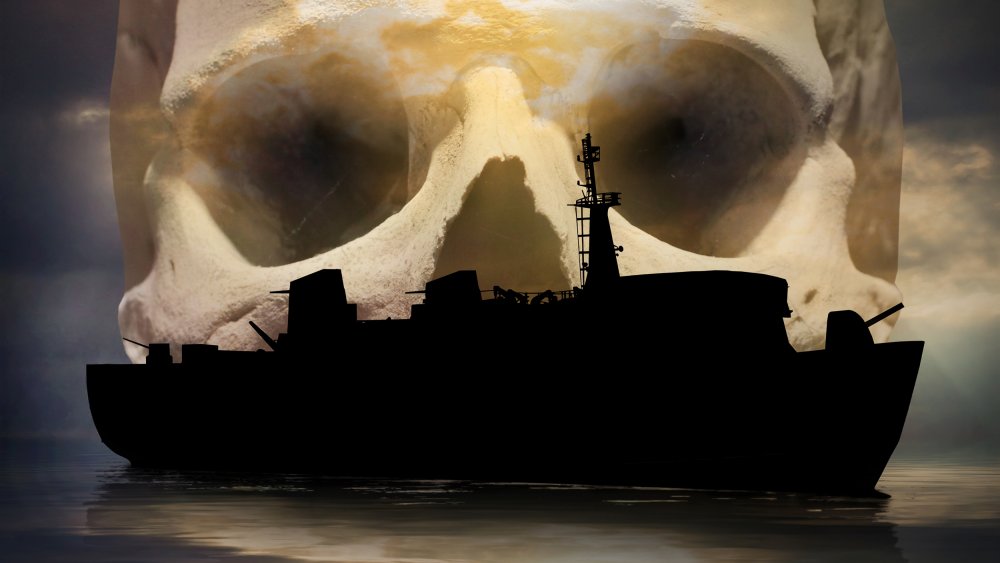Creepy Tales Of The Shipwrecks In The Great Lakes
It's hard to over-stress the importance of the Great Lakes when it comes to America's history and the development of entire industries. Throughout the 1800s, the Great Lakes were the backbone of the grain, coal, lumber, and iron industries: They delivered the riches of the Midwest to the rest of the country, and at a time when growth was skyrocketing, that was of indescribable importance. According to the Smithsonian, by 1893, there were around 3,000 boats regularly making runs across the Great Lakes — lakes that are so big, says Michigan Sea Grant, that they have their own microclimate.
And that's important to our tale. Marine Insight estimates that there are somewhere around 6,000 shipwrecks lying at the bottom of the Great Lakes ... although some historians put the total at more than 25,000. The area has proven deadly for a number of reasons, including that microclimate: The lakes are big enough that they have dangerous waves, storms, and currents just like the ocean, and that has led to tens of thousands of deaths.
It's no wonder, then, that some believe the area to be haunted — not just by the sailors who lost their lives but also by the ships themselves. And sometimes, the creepiest tales have nothing to do with the supernatural at all.
The terrifying ghost corpse that haunts the wreck of the Kamloops
In December 1927, Captain William Brian of the Kamloops wrote a letter to his wife, saying that the weather was turning bad, and he never made it home. According to the National Park Service, the storm signals went up on December 5, and by December 12, the Kamloops was officially one of the missing.
The crew of the Kamloops started washing up on shore in May and June of the following year, and one crewman? He decided to stay with the ship. According to Week in Weird, divers who have explored the wreck of the Kamloops after it was discovered on the bottom of Lake Superior found something with at least three levels of disturbing. For starters, the corpse. They call him Grandpa or Old Whitey, because the cold lake waters have bleached the preserved body a pale, ghostly white. Creepy, sure, but Grandpa can do even better.
Divers say that the whole ship was eerily well-preserved, mostly because of a temperature that lingers just above freezing. Maybe that's why the ghost of Grandpa is often seen walking along the sunken decks as though absolutely nothing is amiss. His corpse, though, seems to know it's dead. Some divers reported that as they swam through the wreckage, Grandpa's pale, bleached corpse floated right alongside them. Sometimes, he even touched them, but they say he never seemed angry ... just glad to have some company, if only for a little while.
No one knows what happened to the Great Lakes' most famous wreck
It has been called the Titanic of the Great Lakes, and it has been immortalized in a truly excellent song by Gordon Lightfoot. It's the Edmund Fitzgerald, but as famous as she is, no one knows why she sank. There was a storm that fateful day, but that's really nothing unusual for the Great Lakes. According to MLive, a massive gale swept across Lake Superior on November 10, 1975, and suddenly, she was gone, with all 29 men trapped on board. The Detroit News says that all sorts of explanations have been put forward as to why she sank, including UFO interference.
That ... seems unlikely, so what are the facts? Only a few people have headed into the depths of the lake to see the actual shipwreck. The depth and the cold — coupled with the fact that the living relatives of the crewmembers consider it a gravesite — means that it's not a common dive. We do know that the ship sits in two pieces, and early theories suggested that a faulty hatch cover had caused massive flooding which ultimately sank her. Others believe she scraped along a shoal or suffered structural failure.
But here's the creepy one: rogue waves. Meteorologists' models of the storm suggest a series of three 50-foot-plus waves swept over the Edmund Fitzgerald and snapped her in half, and this theory is supported by the report of witnesses on another ship, the Arthur M. Anderson. Worst of all? They were just 17 miles from safety.
Beware the dragon of Lake Superior
Everyone's heard of the Loch Ness Monster, and while Nessie might be the most famous, she's certainly not the only lake monster. Lake Superior has its own, and according to the Jesuit missionaries who first made contact with the native tribes who had long lived in the area, regular sacrifices were necessary to keep the monster satisfied ... and the ships that sailed the lake safe, says SooToday.
A text from 1667, written by Claude-Jean Allouez, called the creature Missibizi. It said that she was blamed for dangerous conditions on the water — and over the years, the sinking of around 400 ships were blamed on the sea dragon. Sometimes she's called Michipissy and sometimes Mishibiji. She has been described as a sturgeon, a dragon, or a water cat and has even been depicted as having the shape of Lake Superior, but she's always credited with either protecting those who sail her waters ... or destroying them.
Northern Ontario Travel says that Lake Superior isn't the only lake rumored to have a centuries-old resident: South Bay Bessie was first sighted in Lake Erie in 1793. Seneca legend says a serpentine creature called Gaasyendietha lives in Lake Ontario, and Lake Huron's Mishebeshu (which translates to "great lynx") lives in an underwater den at the mouth of the Serpent River. Could our disrespect explain why these creatures have sunk so many ships?
The Lake Michigan Triangle
To the south is the city of Benton Harbor, Michigan. To the east is Ludington, Michigan. And to the west? Manitowoc, Wisconsin. Those are the markers of the three corners of the Lake Michigan Triangle, a swath of water where mysterious disappearances — reminiscent of the Bermuda Triangle — have happened with shocking frequency.
According to Milwaukee Magazine, Lake Michigan is usually pretty easy to navigate, but over the course of hundreds of years, well ... take the Thomas Hume. She set out across the lake in 1891, alongside the Rouse-Simmons. The second ship turned back, worried about clouds on the horizon. The Hume continued ... and disappeared. Fast-forward 21 years, and it was the Rouse-Simmons' turn: She disappeared, too. When they were finally discovered (at different times), they were sitting at the bottom of the lake, in almost perfect condition, with no clues as to why they'd sunk.
There are a ton of stories just like them: The Rosabelle capsized in 1921, with no signs of collision. Her crew was never found, and neither was Captain George R. Donner. It was 1937, and he had just guided the O.M. McFarland through treacherous waters when he decided to get some rest. When crew members went to wake him, he was gone. Also gone? Northwest Airlines Flight 2501. The plane was flying over the triangle in 1950 when it was denied permission to descend. Then? Gone. No wreckage has ever been found. What heck, Lake Michigan?
Is a mysterious underwater Stonehenge to blame?
It's easy to blame mysterious accidents, disappearances, and shipwrecks on UFOs because you're totally not expected to have proof. But sometimes, proof of something eerie shows up, and we're left to explain it again. That's kind of what happened in 2007, and underwater archaeologists are still scratching their heads.
That's the year that archaeology professors Mark Holley and Brian Abbot did a sonar search of the bottom of Lake Michigan. They were looking for shipwrecks, but according to Milwaukee Magazine, they found something stranger: a line of stones that looked very deliberately arranged and reminded them of Stonehenge. And don't worry, it gets weirder.
The stone structure was only submerged by about 40 feet of water, so they sent a team of divers down to see what they could see (via ZME Science). The boulders were between 3.5 and 5 feet tall, and one still bore the traces of what looked like a carving of a mastodon. They estimated that they'd found the 10,000-year-old remains of a monument built by an ancient civilization that lived alongside post-Ice Age animals, and while that's pretty cool in its own right, some suggest that the mysterious monument might have something to do with the tragedies that befall the ships that sail over it. The world's full of strange things, so maybe don't discount that?
The single shipwreck that claimed more lives than any other
According to Milwaukee Magazine, the largest open-water loss of life on the Great Lakes was the Lady Elgin disaster in 1860. She collided with a smaller boat, the Augusta, which made it safely to port, but the Lady Elgin sank with 300 passengers on board. Next? There's the SS Eastland, which didn't even make it out of port.
It was a cool July day in 1915, and the Eastland was getting ready to shuttle 2,573 people from Chicago to a park 38 miles across Lake Michigan. It was supposed to be a brilliant afternoon out, but there was a huge problem: New regulations that increased the number of lifeboats, rafts, and life preservers on board a ship made the Eastland – with its shallow bottom — incredibly top-heavy. Even though Smithsonian Magazine notes that those in charge of the shipping companies knew this and warned legislators that the consequences of their new "safety" laws would be more deaths, no one listened. They didn't even listen when it nearly capsized in 1904 and again in 1906.
And so, when the Eastland – which was originally only supposed to carry 500 passengers — took on its weekend passengers that day in Chicago, it listed 45 degrees to port and rolled completely onto its side just two minutes later. The lifesaving equipment was never launched, and in spite of the efforts of around 10,000 nearby civilians who tried to help, 844 people died.
The ship that sank directly onto another wreck
According to The Homestead, there are around 50 shipwrecks at the bottom of the Manitou Passage alone. One of them is still visible: She's the wreck of the Francisco Morazan, and her story is a pretty perfect illustration of just how many shipwrecks there are in the Great Lakes.
She left Chicago on November 27, 1960, and sailed into driving winds and snow. The ship — laden with 1,000 tons of general cargo — ran aground just south of South Manitou Island, where she still sits well above the water (pictured). No one was hurt, though the ship was declared unsalvageable. All that cargo was left for enterprising people to loot, but that's not the weird thing.
According to the Manitou Passage Underwater Preserve, the Morazon sits above water in part because she ran aground on the wreck of another ship, the Water L. Frost. The Frost ran aground in the exact same spot in 1903 and was largely broken to pieces when the Morazon hit right on top of her.
The Black Dog of Lake Erie
We're going to hop on over to Lake Erie for this tale that's terrifying in both a supernatural sort of way and a "people are terrible" sort of way.
It all started with a ship heading through Welland Canal, says GWVM. The story goes that the ship's mascot, a massive black Newfoundland, was somehow sent tumbling overboard into the water. The crew reportedly thought it was hilarious: The story says that they laughed as the dog struggled to swim alongside the ship and keep up with his not-so-faithful crew. Things went from bad to worse when the dog was crushed in the lock's gate — traffic was stopped until they could remove the dog's body, and people? They're such jerks sometimes.
While the crew of that ship recounted hearing the howling and baying of the dog they hadn't been bothered to save, echoing over the deck of their ship every night, there are other stories of the dog, too. He was said to be seen on the decks of ships that were going to sink, and according to Maritime History of the Great Lakes, he appeared on the deck of the Isaac G. Jenkins just before she sank in 1875 and again on the deck of the Mary Jane just before she mysteriously disappeared in 1881. A warning ... or a curse?
A ghost ship caught on film?
In 2016, a professional cameraman named Jason Asselin caught something eerie on Lake Superior. According to Forbes, he was shooting footage for a music video when he saw something on the horizon: It was a tall-masted ship, reminiscent of a pirate ship. And the video is pretty darn convincing — when he zooms in, you can see a surprising amount of detail and what apparently looks like sails flapping in the wind.
Is it a ghost ship? There are certainly enough possibilities that have found their way to their final resting place beneath the waves. The Weather Channel, however, (via MLive) thinks they might have another explanation: A thermal inversion, a layer of warm air above a layer of cold air, can cause a particular distortion that would allow a person to see past the Earth's curve. But even they admit it's just a theory, and it would be a rare occurrence, given the time of year. So ... ghost ship?
The first European sailing ship to reach Michigan is still missing
For anyone who's hunting shipwrecks in the Great Lakes, the white whale is the 17th-century Le Griffon. According to the Great Lakes Exploration Group, the ship was built by one of the first French explorers in the area: Rene-Robert Sieur de La Salle. They set out from Niagara on August 7, 1679, and the ship was still afloat in mid-September. Things were going so well that La Salle was getting ready to build a second ship. But on September 18, Le Griffon dropped off the face of history.
There are three theories about what happened: The ship was captured and burned, it sank in a storm, or there was a mutiny that led to the ship being scuttled. Even La Salle himself wasn't sure what happened, and if you fast-forward a few centuries, people are still trying to find traces of the ship. Atlas Obscura says that between 2002 and 2017, there were 17 different sites claimed to be the final resting place of Le Griffon, but nothing ever panned out. Some of the finds have proved to not even be ships, so there's that. There was, however, one intriguing find that developed in the 1890s: A lighthouse keeper on Manitoulin Island discovered six skeletons. One had a very large skull — in line with La Salle's 7-foot-tall pilot.
Will the fate of Le Griffon ever be discovered, or will she keep her secrets?
The very real Witch of November
According to the National Post, more ships sink in the Great Lakes in November than any other month. Why? She's called the Witch of November.
That's the name given to the violent storms that hit the Great Lakes every November. The Farmers' Almanac says that they're the result of something unique: The Great Lakes are so large that they're more appropriately called freshwater seas, and their size means they have their own weather system. In mid-November, they're the site of a collision between low-pressure, cold air from the north and warm air from the south. When the two fronts meet, the resulting storms are hurricane-level gales with winds over 80 mph, gusts of more than 100 mph, and waves more than 20 feet high. (That's a storm building over Lake Erie in the picture.)
Weatherbug says that some years are worse than others. Thirteen ships sank during a single storm in 1913, unable to overcome white-out snows and 35-foot waves. Stories are heartbreaking: One man on board the barge Plymouth wrote a message in a bottle, saying goodbye to his children. It washed ashore 11 days after the storm subsided. Rescue workers along the shore collected a $5-per-corpse bounty, and it wasn't long before the coroner ran out of shrouds and had to wrap the frozen bodies in newspaper. Worse, some of the dead had made it into lifeboats, only to freeze and wash ashore.
The Ghost Fleet of the Great Lakes
It's said that some of the ships that met their end on the Great Lakes are condemned to keep wandering ... and the tales of those who've met the ships crewed by the dead are nothing short of terrifying.
Zenith City says that on stormy nights, some sailors claim to see the Bannockburn, a ship that disappeared in 1902. The only trace ever discovered was a single life preserver, and since then, she's been seen so many times that she's called the "Flying Dutchman of Lake Superior."
Then there's the Hudson. She disappeared in 1901, and in the 1940s, a tugboat captain came across a rusty ship covered in sludge. He boarded her and later said that he had met the captain and the helmsman — it was the Hudson, and they told him that they had been condemned to relive their sinking every September 16. That day was September 16 ... and if the tug captain wanted to live, they told him, he'd better leave. Quickly.
Memories of the Prairie says that the Western Reserve can sometimes be seen, too — or, more accurately, heard. The laughter of the dead crew is said to echo across the water on cloudless nights. And sometimes, sailors catch a glimpse of the W.H. Glicher, her captain at the wheel, her fog whistle blowing. She disappeared in 1892. Are they ghost ships, or are they tricks of tired minds who know just how many dead men lie below?
